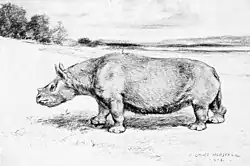| Teleoceras | |
|---|---|
 | |
| Specimen at the Natural History Museum of LA | |
| Scientific classification | |
| Domain: | Eukaryota |
| Kingdom: | Animalia |
| Phylum: | Chordata |
| Class: | Mammalia |
| Order: | Perissodactyla |
| Family: | Rhinocerotidae |
| Subfamily: | †Aceratheriinae |
| Genus: | †Teleoceras Hatcher, 1894 |
| Type species | |
| †Teleoceras major | |
| Species[1] | |
| |
| Synonyms | |
Teleoceras (Greek: "perfect" (teleos), "horn" (keratos)[4]) is an extinct genus of rhinocerotid. It lived in North America during the Miocene and Pliocene epochs during the Hemingfordian to the end of Hemphillian from around 17.5 to 4.9 million years ago.[5][6] It grew up to lengths of 13 feet (4.0 meters) long).[7]
Description


Teleoceras had much shorter legs than modern rhinos, and a barrel chest, making its build more like that of a hippopotamus than a modern rhino. Based on this description, Henry Fairfield Osborn suggested in 1898 that it was semi-aquatic and hippo-like in habits. This idea persisted for about a century, but has recently been discounted by isotopic evidence.[6] Some species of Teleoceras have a small nasal horn, but this appears to be absent in other species.[8] Teleoceras has high crowned (hypsodont) molar teeth, which has historically led to suggestions that the species were grazers. Dental microwear and mesowear analysis alternatively suggest a browsing or mixed feeding (both browsing and grazing) diet.[9]
Discovery
Teleoceras is the most common fossil in the Ashfall Fossil Beds of Nebraska. In fact, its remains were so numerous and concentrated that the building housing the greatest concentration of Ashfall fossils is called the "Rhino Barn". Most of the skeletons are preserved in a nearly complete state. One extraordinary specimen includes the remains of a Teleoceras calf trying to suckle from its mother.[10] This animal was featured in the episodes "Are Rhinos Dinos?" and "Dawn Of The Cats" of the Paleoworld series.
Extinction
Teleoceras went extinct in North America alongside Aphelops at the end of the Hemphillian, most likely due to rapid climate cooling, increased seasonality and expansion of C4 grasses, as isotopic evidence suggests that the uptake of C4 plants was far less than that in contemporary horses.[6] The Gray Fossil Site in northeast Tennessee, dated to 4.5-5 million years ago, hosts one of the latest-known populations of Teleoceras, Teleoceras aepysoma.[11]
References
- ↑ Prothero, 2005, p. 94.
- ↑ McKenna & Bell, 1997, p. 483.
- ↑ Prothero, 2005, p. 122.
- ↑ "Glossary. American Museum of Natural History". Archived from the original on 20 November 2021.
- ↑ (Prothero, 2005)
- 1 2 3 Wang, B.; Secord, R. (2020). "Paleoecology of Aphelops and Teleoceras (Rhinocerotidae) through an interval of changing climate and vegetation in the Neogene of the Great Plains, central United States". Palaeogeography, Palaeoclimatology, Palaeoecology. 542: 109411. Bibcode:2020PPP...542j9411W. doi:10.1016/j.palaeo.2019.109411.
- ↑ "Region 4: The Great Plains". geology.teacherfriendlyguide.org. Retrieved 2021-06-26.
- ↑ Short, Rachel; Wallace, Steven; Emmert, Laura (2019-04-27). "A new species of Teleoceras (Mammalia, Rhinocerotidae) from the late Hemphillian of Tennessee". Bulletin of the Florida Museum of Natural History. 56 (5): 183–260. doi:10.58782/flmnh.kpcf8483. ISSN 2373-9991.
- ↑ Mihlbachler, Matthew C.; Campbell, Daniel; Chen, Charlotte; Ayoub, Michael; Kaur, Pawandeep (February 2018). "Microwear–mesowear congruence and mortality bias in rhinoceros mass-death assemblages". Paleobiology. 44 (1): 131–154. doi:10.1017/pab.2017.13. ISSN 0094-8373.
- ↑ "Ashfall Fossil Beds". Archived from the original on 2011-05-18. Retrieved 2005-12-13.
- ↑ Short, Rachel A; Wallace, Steven C. "A New Species of Teleoceras (Mammalia, Rhinocerotidae) from the Late Hemphillian of Tennessee".
{{cite journal}}: Cite journal requires|journal=(help)
Bibliography
External links
![]() Media related to Teleoceras at Wikimedia Commons
Media related to Teleoceras at Wikimedia Commons